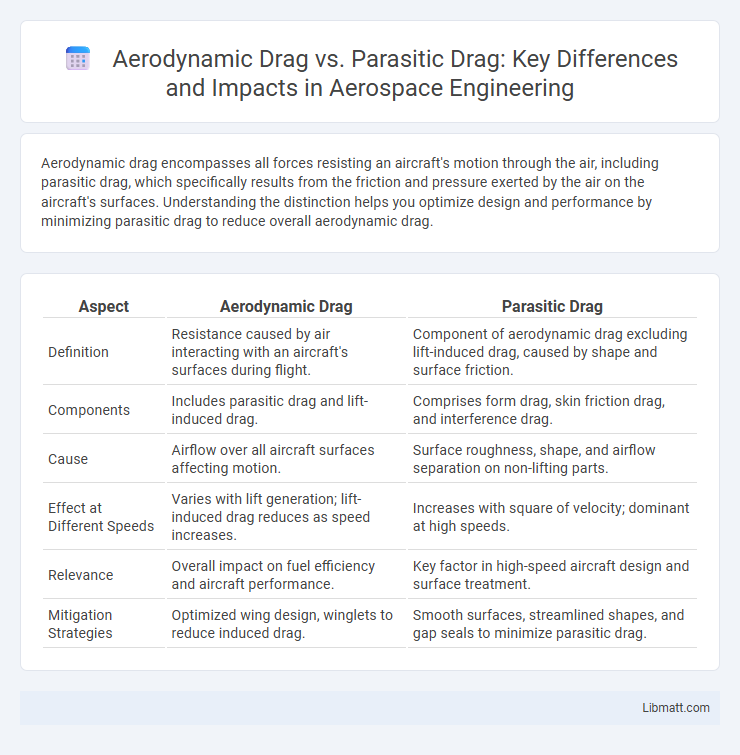Aerodynamic drag encompasses all forces resisting an aircraft's motion through the air, including parasitic drag, which specifically results from the friction and pressure exerted by the air on the aircraft's surfaces. Understanding the distinction helps you optimize design and performance by minimizing parasitic drag to reduce overall aerodynamic drag.
Table of Comparison
| Aspect | Aerodynamic Drag | Parasitic Drag |
|---|---|---|
| Definition | Resistance caused by air interacting with an aircraft's surfaces during flight. | Component of aerodynamic drag excluding lift-induced drag, caused by shape and surface friction. |
| Components | Includes parasitic drag and lift-induced drag. | Comprises form drag, skin friction drag, and interference drag. |
| Cause | Airflow over all aircraft surfaces affecting motion. | Surface roughness, shape, and airflow separation on non-lifting parts. |
| Effect at Different Speeds | Varies with lift generation; lift-induced drag reduces as speed increases. | Increases with square of velocity; dominant at high speeds. |
| Relevance | Overall impact on fuel efficiency and aircraft performance. | Key factor in high-speed aircraft design and surface treatment. |
| Mitigation Strategies | Optimized wing design, winglets to reduce induced drag. | Smooth surfaces, streamlined shapes, and gap seals to minimize parasitic drag. |
Introduction to Aerodynamic and Parasitic Drag
Aerodynamic drag is the overall resistance force experienced by an object moving through air, consisting of several types including parasitic drag. Parasitic drag arises from the shape, surface roughness, and interference of components, increasing with the square of velocity and not contributing to lift. Understanding the distinction between total aerodynamic drag and parasitic drag is essential for optimizing aircraft design and improving fuel efficiency.
Defining Aerodynamic Drag
Aerodynamic drag is the total resistance an object encounters as it moves through air, encompassing all forces opposing its motion. It includes parasitic drag, which arises from non-lift-generating components such as surface friction, form drag, and interference drag. Understanding aerodynamic drag helps optimize your vehicle or aircraft for improved efficiency by minimizing unnecessary resistance.
What is Parasitic Drag?
Parasitic drag is a type of aerodynamic drag that opposes an aircraft's motion due to non-lifting components like the fuselage, landing gear, and surface irregularities. It increases with the square of the aircraft's speed, making it a crucial factor in high-speed flight performance. Understanding parasitic drag helps you optimize design and reduce fuel consumption by minimizing surface roughness and streamlining shapes.
Key Differences Between Aerodynamic and Parasitic Drag
Aerodynamic drag encompasses all forces opposing an object's motion through air, including parasitic drag, which specifically arises from shape, surface roughness, and form friction. Key differences highlight that parasitic drag excludes lift-induced drag and is prominent at higher speeds where air resistance dominates, while aerodynamic drag covers a broader range of factors affecting flight efficiency. Understanding these distinctions is vital for optimizing aircraft design and improving fuel economy by minimizing total drag forces.
Components of Parasitic Drag
Parasitic drag includes components such as form drag, caused by the shape and frontal area of the aircraft, skin friction drag resulting from the surface roughness and texture, and interference drag occurring where airflow streams merge on aircraft surfaces. These elements directly influence the total aerodynamic drag, affecting efficiency and performance. Understanding these components helps optimize your aircraft's design to reduce unnecessary drag and improve fuel economy.
How Aerodynamic Drag Impacts Vehicle Performance
Aerodynamic drag directly affects vehicle performance by increasing resistance against motion, leading to higher fuel consumption and reduced top speeds. Parasitic drag, a component of aerodynamic drag including form drag, skin friction, and interference drag, contributes significantly to this resistance, especially at higher velocities. Minimizing parasitic drag through streamlined vehicle design and smooth surfaces enhances efficiency, improves acceleration, and lowers emissions.
Factors Influencing Parasitic Drag
Parasitic drag is influenced primarily by factors such as surface roughness, shape, and frontal area of the object moving through the air. Increasing surface irregularities or discontinuities disrupt airflow, causing higher skin friction drag, while blunt or non-streamlined shapes elevate pressure drag significantly. Minimizing parasitic drag involves smoothing surfaces and streamlining the shape to reduce airflow separation and turbulence.
Methods to Reduce Aerodynamic and Parasitic Drag
Reducing aerodynamic and parasitic drag involves optimizing vehicle shape through streamlined designs that minimize frontal area and promote smooth airflow, incorporating features like tapered tails and rounded edges. Implementing surface treatments such as active airflow control devices, vortex generators, and low-drag wheel covers further decreases resistance by managing boundary layer behavior. Utilizing lightweight materials and minimizing external protrusions also contributes to significant drag reduction, enhancing fuel efficiency and overall performance.
Real-World Applications and Case Studies
Aerodynamic drag significantly impacts fuel efficiency and performance in automotive and aerospace industries, with parasitic drag--comprising form drag, skin friction, and interference drag--being a critical subset addressed through design optimizations. Case studies on high-speed trains and commercial aircraft reveal that minimizing parasitic drag via streamlined shapes and smooth surfaces reduces overall resistance, enhancing speed and reducing energy consumption. Real-world applications in Formula 1 racing exploit advanced computational fluid dynamics to fine-tune aerodynamic components, demonstrating the tangible benefits of targeting parasitic drag for competitive advantage.
Conclusion: Choosing Focus for Maximum Efficiency
Maximizing vehicle efficiency requires prioritizing parasitic drag reduction, as it constitutes the majority of aerodynamic resistance at higher speeds. Streamlining body shapes and minimizing surface roughness significantly decrease parasitic drag, thereby improving fuel economy and performance. While induced drag is critical during lift generation, parasitic drag's impact on energy consumption makes it the primary focus for optimizing aerodynamic design.
Aerodynamic Drag vs Parasitic Drag Infographic

 libmatt.com
libmatt.com